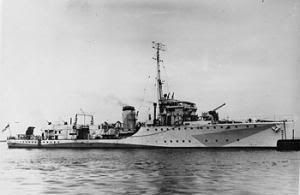
Stats from Colledge's Ships of the Royal Navy, which can also be found on the Wikipedia page for this ship:
Launched: 18 April, 1939
Commissioned: 7 September, 1939
Decommissioned: 21 April, 1947
Length: 234 ft
Beam: 26 ft 6 in
Draught: 6 ft 6 in
Displacement: 580 tons
Compliment: 55 enlisted, 5 officers
Speed: 20 kts
Power Plant: 2 X 3600 hp geared steam turbines
Armament: 1 QF 4 Mark V 4'/45 caliber gun mounted forward
4 .50 caliber Vickers machine guns
2 depth charge racks, stern mounted
The HMS Shearwater was the last of the Kingfisher class sloops/corvettes, a class which was designed in the mid 1930's as a limited ocean escort vessel for coastal and short ocean escorts. This and subsequent classes came into heavy use at the onset of World War II, where they were needed for convoy escorts across the Atlantic. Upon completion, the Shearwater was based out of various shipping ports along the southern coast of Britian to operate in concert with other corvettes and destroyers, usually multiple corvettes and a single destroyer as flotilla commander, to escort British shipping out into the Atlantic, providing protection from enemy aircraft and U-Boats. The Shearwater is most notable for being the corvette under the command of nautical themed author Nicholas Monsarrat, his first command, and thought to be the first patrol craft (sloop, corvette, patrol boat, or destoyer) under the command of a RNVR officer.
One item that the Shearwater brings up is her confusion in classification between sloop of war, and corvette. By this time, both classifications were being used to refer to small patrol craft; the aspect of using the rig of the ship to identify it became for the most part extinct with rise of the age of steam. However, British guidelines of the 1930's indicated that all small patrol craft not intended for fleet deployment would be classified as sloops. It wasn't until the explosion of shipbuilding in the Second World War that there became a distinction among these small patrol craft. The most commonly accepted difference is in size and propulsion, the sloops were generally smaller and single screwed, while corvettes were generally larger and carried twin screws. Thus, by this classification, the Shearwater would be a corvette, although such details are largely left to the history books in this day in age. But nonetheless an interesting topic of discussion.
No comments:
Post a Comment